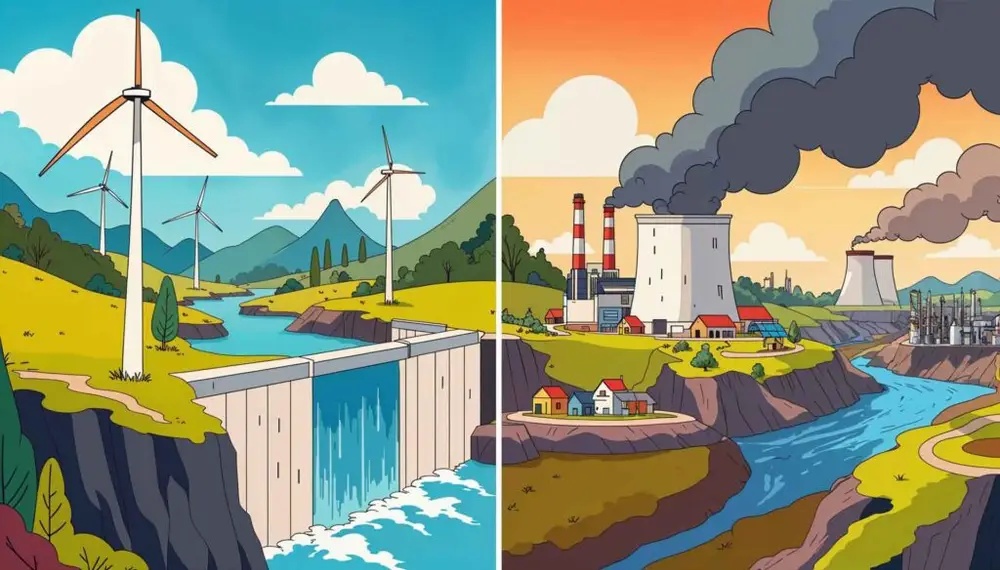The U.S. energy market is changing as governments and environmental agencies press to switch from fossil fuels to clean energy sources like solar, wind, and nuclear power.
As technology advances, how energy is produced, distributed, and consumed changes, too. This increases the need to modernize energy grids and update the country’s infrastructure, resulting in a growth of opportunities in the energy job market.
Adopting renewable and clean energy sources has led to the evolution of the energy market, the challenges of transitioning, and an emerging set of job opportunities.
The Energy Market in the U.S.
The energy market is the system where energy is produced to be traded, sold, and used based on consumer demand.
While the energy market encompasses the entire system, it comprises multiple sectors based on the source or type of energy produced.
The energy market in the U.S. is primarily made up of sectors consisting of:
- Petroleum
- Coal
- Natural gas
- Electricity
- Renewable energy: solar, wind, hydroelectric, nuclear, biofuels
Each of these sectors then play its role by offering its product in the different types of energy markets.
“Energy in the U.S. is transitioning from non-renewable traditional petroleum to renewable sources that are cleaner for the environment.“
Types of Energy Markets
The type of energy market changes based on who is involved in the transaction, who generates energy, and who purchases it.
Wholesale Energy Markets involve producers selling energy in bulk to distributors. Wholesale markets can be divided into two groups: capacity markets and energy-only markets.
Both compensate the energy generators. However, capacity markets, the more common option, pay the generators for the ability to provide a set amount of energy before it’s provided. Capacity markets can incentivize generators to continue producing even during low demand.
Energy-only markets pay generators based on the amount of energy they generate.
Retail Energy Market is where energy is sold by distributors to consumers like residential households and businesses.
Key Players in the U.S. Energy Market
There are a number of players in the energy market in addition to the energy jobs for designing, implementing, and maintaining energy systems.
- Producers: These companies generate energy from a source that may be renewable or non-renewable. They then sell the energy to distributors.
- Distributors: Often, utility companies are responsible for buying energy in bulk and then delivering it to consumers.
- Regulatory Bodies: Groups such as the Federal Energy Regulatory Commission (FERC) and other government agencies, oversee market operations and investigate monopolies. They are concerned with interstate transmission and wholesale costs.

The Shift from Petroleum to Clean Energy Sources
Energy in the U.S. is transitioning from non-renewable traditional petroleum to renewable sources that are cleaner for the environment.
This transition is driven by several factors. These factors include environmental concerns, pressure from government regulations, and technological advancements that allow residential and commercial users to afford to switch financially.
The shift is still happening, and while many countries, like the U.S., have made projections that by 2050, 44% of all of the energy used in the U.S. will be from renewable sources. Experts are unsure if that is a reasonable timeline.
Regardless of the timeline, traditional and emerging technologies are shaping the future of the U.S. energy market.
Traditional Petroleum and Nonrenewable Fuels
The U.S. has vast oil reserves, which have powered transportation and industrial operations. When supported by other traditional fuels like natural gas and petroleum, reserves allowed the country to maintain energy independence.
Most often used to generate electricity, natural gas, and coal have power electronics and heated homes.
Even with environmental concerns, petroleum and other fossil fuel-based energy sources still account for over 70% of U.S. energy consumption. Petroleum is primarily used in transportation (planes, cars, trucks), although the number of electric cars and trucks has increased.
Coal use is beginning to decline as the renewable energy market increases. On the other hand, natural gas, a cleaner-burning energy source than coal, oil, or petroleum, has seen a marked increase.
Natural gas is converted into electricity, and demand for natural gas peaked in 2023 as electricity demand increased. The U.S. electric power sector has used more natural gas every year since 2018.
While natural gas is cleaner, it’s still a nonrenewable resource, and once the gas supply is exhausted, another fuel source must be found.
“Although considered a traditional energy source, nuclear power is a stable, carbon-free energy source that doesn’t deplete Earth’s resources.“
The Problem with Fossil Fuels
In addition to running out of supply, burning fossil fuels, which occurs when producers process fuels to release power, releases carbon dioxide and other greenhouse gases into the atmosphere. These gases blanket the earth and have been shown to harm the environment.
One reason consumers have wanted to transition from petroleum to clean energy sources is global climate change.
According to the United Nations Climate Action, fossil fuels such as coal, oil, and natural gas are the largest contributors to climate change. They “account for over 75 percent of global greenhouse gas emissions and nearly 90 percent of all carbon dioxide emissions.”
Rising Renewables
Although considered a traditional energy source, nuclear power is a stable, carbon-free energy source that doesn’t deplete Earth’s resources. It provides consistent, large amounts of power to run plants without greenhouse gases.
Nuclear energy, however, has challenges regarding cost, safety, and waste disposal that make it less preferred than other energy sources.
Solar and wind energy have experienced a rise in popularity too. This has encouraged more people to work on improving quality, lowering costs, and supporting policies that support the sector’s growth.
Solar energy can be used in residential, commercial, and industrial applications without impacting the surrounding environment. Residential consumers in some areas have even been able to begin using solar and selling energy back to distribution centers.
Wind energy also contributes to the nation’s energy grid, especially in states with large wind farms, such as California, Iowa, and Texas.
To conclude, wind energy requires more land for wind farms than solar energy does for panels. However, it has benefited from retired farmland and the use of land that can’t be used for anything else.
Benefits of Government Incentives
The American government has implemented incentives at the state and federal levels, from tax incentives to grants and benefits for businesses that adopt renewable energy.
The Investment Tax Credit (ITC) gives businesses tax or production credits for pursuing solar or wind energy. It also encourages investment and helps offset the costs of taking on clean energy projects.
The Challenges of Energy Transition
Transitioning from fossil fuels to renewable resources cannot be done overnight. Even if every business decided to change tomorrow, there would be significant hurdles:
- Infrastructure upgrades: the current energy grid is designed for fossil fuels and would need to be updated to handle decentralized energy sources.
- Energy storage: Renewable energy sources can be intermittent as solar and wind sources fluctuate daily. Producers would need to be able to capture energy and store it without significant loss. By this way, there is a constant supply for consumer demand.
- Economic impact: The shift in demand from fossil fuels to renewable energy would mean a change of employment for everyone working in coal, oil, and natural gas. Retraining would be necessary, and even more workers would be required to meet the new demand.
- Current technology: Although solar and wind power are growing, many plants that produce energy from these renewable sources still require natural gas to run the plant. Technology doesn’t yet exist that can support large scale operations.
Although the U.S. may not be ready to transition completely from fossil fuels to renewable energy, the energy market is becoming increasingly diverse. While renewable energy was once a small player in the mix, it is now a critical component.
“The energy market shifts constantly and offers new employment opportunities.“
Off-shore wind farms and large solar farms that produce a steady and reliable stream of energy have enabled businesses to imagine what operating on only renewable energy might look like.
Electric vehicles whose electricity comes from renewable resources and biofuel diesel alternatives show what the transportation industry might be capable of in the future without the use of fossil fuels. This demand is also encouraging businesses to invest in renewable options.
Shifting from petroleum to clean energy is happening rapidly, and while there are challenges, governments and modernized infrastructure are helping to meet demands.
Exploring the Current Energy Job Market
The energy sector offers a wide range of job opportunities. Traditional and renewable energy industries employ people from various backgrounds and skill sets. Platforms like EnergyJobSearch can help job seekers find suitable jobs in the energy industry.
Current Energy Market Opportunities
Traditional energy jobs in oil, gas, and coal are still in demand. Jobs include geologists, pipeline workers, drilling rig engineers, and data scientists.
With the rise of renewable energy, the sector is constantly growing. Jobs include positions as solar engineers, wind turbine technicians, and energy storage engineers in the solar, wind, and battery storage sectors.
There are also opportunities for positions related to emerging technologies, such as cybersecurity, the need to modernize grids, upgrading infrastructure, and electric vehicles.
The energy market shifts constantly and offers new employment opportunities.
Conclusion
By embracing new technologies and understanding that change won’t come overnight, the U.S. stands to become a major player on the world renewable energy stage. Renewables’ growth offers a picture of a clean energy future that supports sustainability goals.
However, the biggest shift is the growth of job opportunities for energy workers. Infrastructure needs to be upgraded, and even more advancements need to be made before the U.S. moves entirely away from fossil fuels.
Renewable energy can create economic and environmental benefits and a more resilient energy market.










